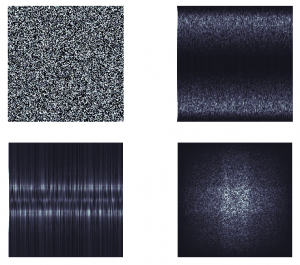This is a vastly subjective subject; I would say that it is a little bit like politics, as visceral reactions can be generated by noise. One’s listening pleasure can always be someone else’s irritating nuisance, yet we could hardly do without it. We actually need noise; noise makes all kinds of things possible. And fittingly, to my earlier comparison with politics to which Aristotle described as “the art of the possible”, I would argue that this applies also to noise.
There is a great majority of people who would agree to the extremes: a jackhammer makes horrible sounds, and a cat’s purring is very soothing. One is really loud, the other really soft, but they do share a rhythmic pattern, which makes them hard to ignore. Loudness is not a factor when we listen to a large waterfall (very loud) or a refrigerator (pretty soft). Most would agree that the fridge is the more annoying one, but these two share a linearity that makes them easier to tune out. These are the types of sounds that we are aware of, which can be defined subjectively as ‘noise’. The type of noise that I’m interested in is the type which we are least aware. This type of noise has more general applications, and is not confined to the realm of sound; it is also visual and statistical. It is the true essence of noise, and there is nothing subjective about it.
The definition of this noise is scientifically quantified and qualified, giving it different ‘flavors’ named by colors: white, pink, brown and even black. These colors correspond to the type of randomness, amplitude and graininess of the noise pattern. For example, white noise is broad and dense, widely distributed over the spectrum like white light (white noise is an idealized absolute only used for theoretical purposes, and needs infinite energy); on the other hand, brown is more granular and more random, like the jiggling of individual molecules called “Brownian Motion” from which it takes its name, and is softer to the ear. Pink sits in between brown and white; it is what we hear as “white noise”. Black noise is close to silence.
So what is so important about noise? Why do we need it so much? I could go through a long list but one example that is close to our musical ear is the case of vinyl. Here are some interesting applications of noise that we don’t necessarily hear consciously:
Small amounts of noise can improve hearing by helping the inner ear detect frequency signals. This is the so-called stochastic resonance effect.
The pixels in a grayscale image can be too faint to cross the threshold of visibility; adding noise energy can sometimes boost the signal above the threshold. This stochastic resonance effect or noise benefit arises in numerous physical and biological systems where a small amount of noise can nudge the system into a new state.
Noise can benefit nervous systems because small amounts of it can improve how neurons process signals- or at least it does so in almost all known models of neurons.
These facts show that noise plays an important role in our perceptions. So how is it that a noisy medium (according to all measurements made with devices such as a spectrograph) such as vinyl L.Ps. has come roaring back so that its growth has outpaced compact discs, which are in a steady decline? I see several explanations:
- It is a nicer object than CDs, and its size allows for great graphics and cover art, and it has an irresistible retro-chic.
- It will outlast the CD and MP3’s life by far; after all, it is made of vinyl- a close relative to oil, which has already lasted tens of millions of years.
- The analog source of the signals (grooves etched in the plastic need no “code” to decipher); in theory, you could hear the music with your finger nails.
- But most importantly: people like the warm sound that it produces. That last quality is the more puzzling, because wouldn’t a cleaner, clearer sound be more pleasing to the ear than a noisier one?
The conclusion, it can be argued, is stochastic resonance effect. Our ears like noise, which enhances the auditory experience; and more precisely, the noise is a conveyer that carries the waves which create the warmth that makes us feel good. The process of digital sampling by quantizing the data source needed to put music in binary form creates small steps from one sample to the next, resulting in a harsher sound, in particular CDs, which are at a 44 Kilohertz sampling rate (this quantizing effect is much less of a problem at 88 or even better, 196 khz). This resulting sound needs to be ‘smoothed over’ to reclaim the original warmth to please our ears; and what is needed to do this? You guessed it: noise. This process has a name, called ‘dithering’, and it plays a big part in digital sound processing.
LPs are a noisy medium; they generate noise and this is the nature of the medium, and it pleases our ears. So obviously, when we get the ‘original’ unbroken analog path, we notice it. The fact is, we are dwelling more and more in a digital environment, since mainly all of our information and entertainment is digitally served to us through the overwhelming influence that the internet has in our lives. We are feeling the difference when sounds are served to us through an analog medium, and whatever noise may be added back in the process is just icing on the cake.
There is a lot more to explore, and I surely will revisit this topic in the near future.
This blog post does borrow freely from the book Noise by Bratt Kosko, edited by Sarah Pillow
